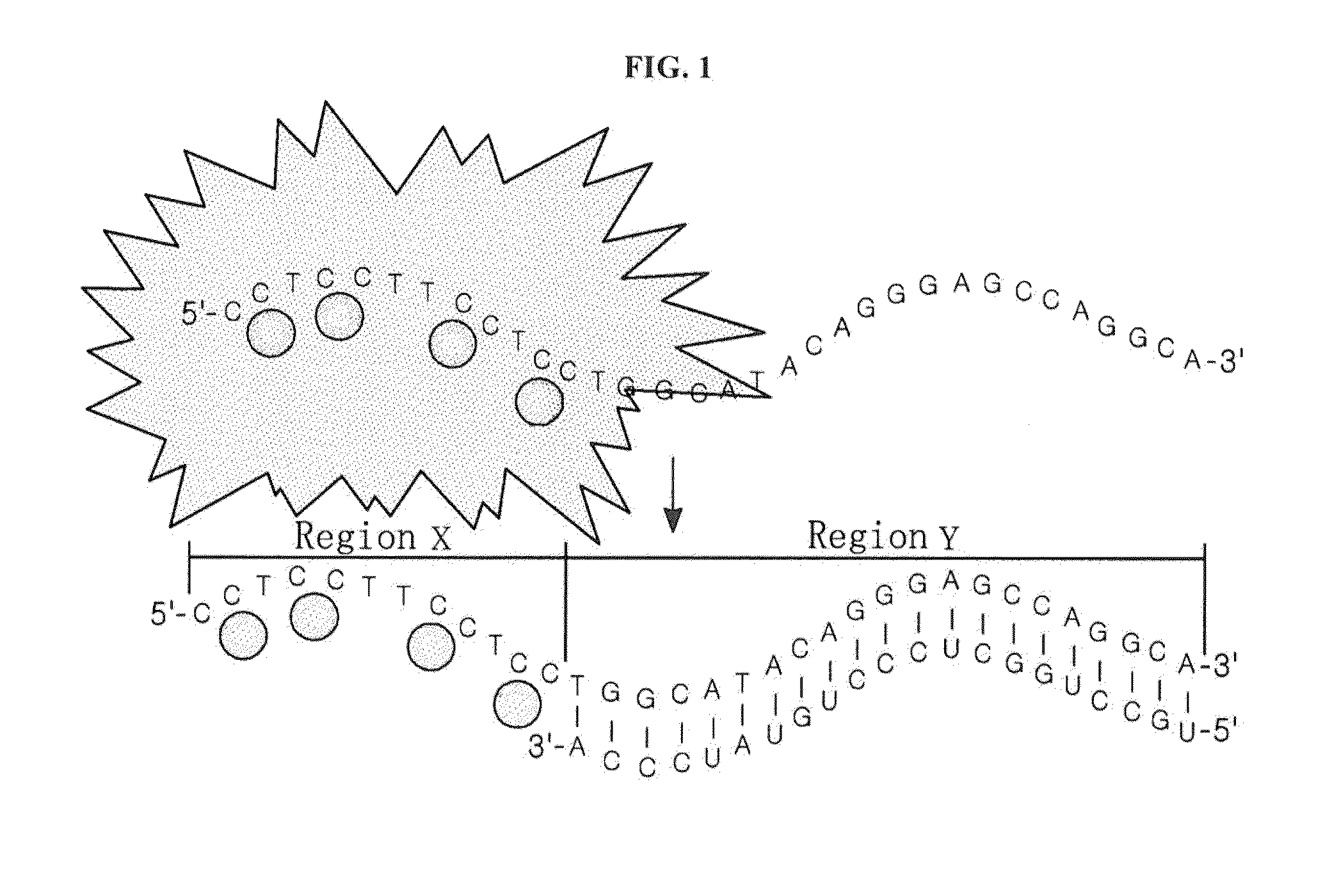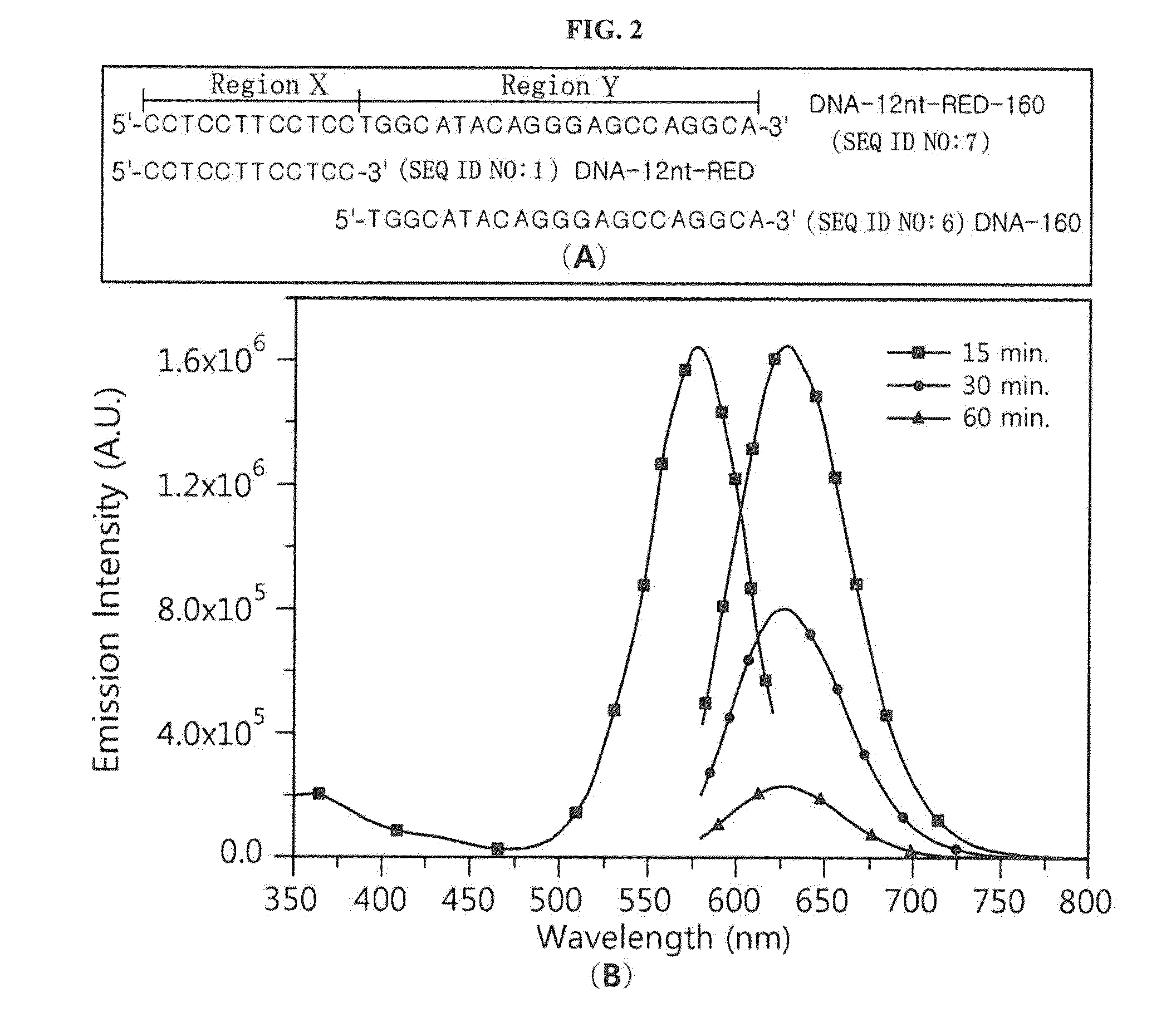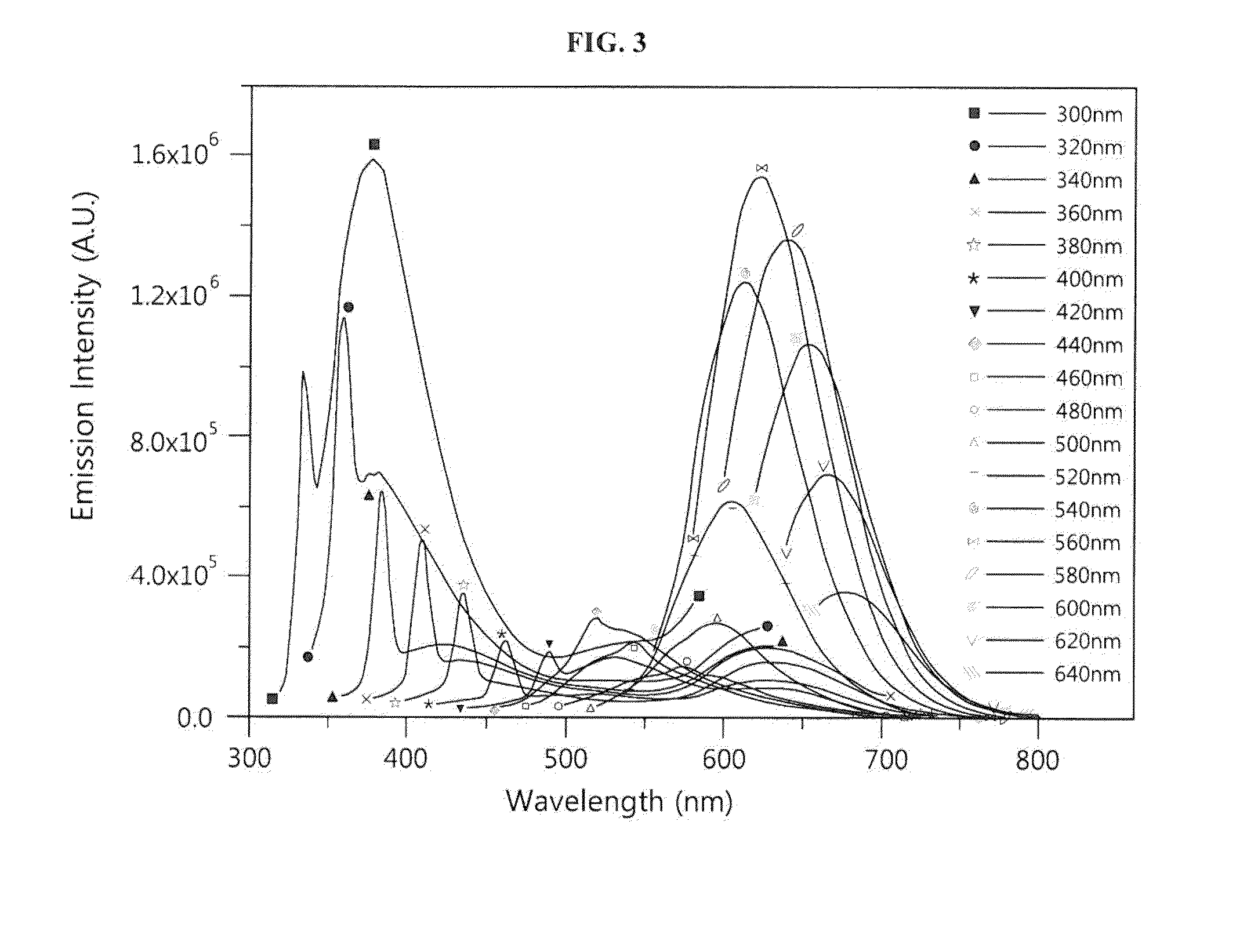Silver nanocluster probe and target polynucleotide detection method using same, and silver nanocluster probe design method
a technology of silver nanocluster probes and target polynucleotides, which is applied in the direction of organic chemistry, biochemistry apparatus and processes, sugar derivatives, etc., can solve the problems of reproducibility of microfluidic chips, inconvenient measurement of impedance values, and difficulty in analysis, so as to achieve rapid and convenient detection, specificity and sensitivity, the effect of rapid and convenient detection
- Summary
- Abstract
- Description
- Claims
- Application Information
AI Technical Summary
Benefits of technology
Problems solved by technology
Method used
Image
Examples
example 1
Construction of a Silver Nanocluster Probe and Analysis of its Emission
[0062]A nucleotide sequence (SEQ ID NO: 6; hereinafter abbreviated as “DNA-160”) complementary to miRNA 160 (SEQ ID NO: 12; hereinafter abbreviated as “miR160”) was added to the 3′ end of an oligonucleotide (SEQ ID NO: 1; hereinafter abbreviated as “DNA-12nt-RED”) of a silver nanoparticle binding region (region X), thereby constructing a silver nanocluster probe (SEQ ID NO: 7; hereinafter referred to as “DNA-12nt-RED-160 probe”) according to an embodiment of the present invention (see FIG. 2(A)). In this Example, the oligonucleotide of SEQ ID NO: 1 for region X, which emits red light when silver nanoparticles bind thereto, was linked to the specific nucleotide sequence region (region Y) that specifically binds to a target polynucleotide, but the present invention is not limited thereto. Various oligonucleotides capable of emitting light at various wavelengths can be used for region X. For example, the oligonucleo...
example 2
Examination of the Ability of the Silver Nanocluster Probe to Detect a Target Polynucleotide by its Specific Binding
[0070]A mixture (final volume: 50 μL) of the silver nanocluster probe (1.5 μM; DNA-12nt-RED-160 probe) prepared in Example 1 and miR160 (target polynucleotide; SEQ ID NO: 12) in the concentration from 0 μM to 1.5 μM was incubated at 25° C. for 15 minutes. In the same manner as described in Example 1, AgNO3 and NaBH4 were added to the incubated mixture, followed by incubation at 25° C. for 1 hour. Then, 450 μL of distilled water was added thereto, and emission spectra were measured and recorded at 620 nm (after excitation at 560 nm) by a fluorimeter (Horiba Jobin Yvon, Fluoromax-4) in a 1 mm quartz cuvette (see FIG. 7(A)). As can be seen from the results in FIG. 7(A), the red emission intensity of the silver nanocluster probe (DNA-12nt-RED-160 probe) decreased depending on the concentration of the target polynucleotide miR160. In other words, it was shown that the amoun...
example 3
Verification of the Specificity of the Silver Nanocluster Probe of the Present Invention
[0074]Solutions were prepared by adding various concentrations (0.2 μM to 15 μM) of miR160 (target polynucleotide; SEQ ID NO: 12) to 1.5 μM of the silver nanocluster probe (DNA-12nt-RED-160 probe; SEQ ID NO: 7) prepared in Example 1 of the present invention. In addition, as a control for testing the specificity of the silver nanocluster probe (DNA-12nt-RED-160 probe) of Example 1 for miR160, solutions were prepared by adding 0.5 μM of RNA-miR163 (SEQ ID NO: 13), 0.5 μM of RNA-miR166 (SEQ ID NO: 14), 0.5 μM of RNA-miR172 (SEQ ID NO: 15) or 0.5 μM of RNA-RY-1 (SEQ ID NO: 16) to 1.5 μM of the silver nanocluster probe (DNA-12nt-RED-160 probe).
[0075]The target polynucleotide miR160 and the control RNAs used to test the specificity of the silver nanocluster probe of the present invention have the following sequences (see FIG. 9(A)):
RNA-miR160:(SEQ ID NO: 12)5′-UGCCUGGCUCCCUGUAUGCCA-3′;RNA-miR163:(SEQ I...
PUM
| Property | Measurement | Unit |
|---|---|---|
| wavelength | aaaaa | aaaaa |
| wavelength | aaaaa | aaaaa |
| wavelength | aaaaa | aaaaa |
Abstract
Description
Claims
Application Information
 Login to View More
Login to View More - R&D
- Intellectual Property
- Life Sciences
- Materials
- Tech Scout
- Unparalleled Data Quality
- Higher Quality Content
- 60% Fewer Hallucinations
Browse by: Latest US Patents, China's latest patents, Technical Efficacy Thesaurus, Application Domain, Technology Topic, Popular Technical Reports.
© 2025 PatSnap. All rights reserved.Legal|Privacy policy|Modern Slavery Act Transparency Statement|Sitemap|About US| Contact US: help@patsnap.com



